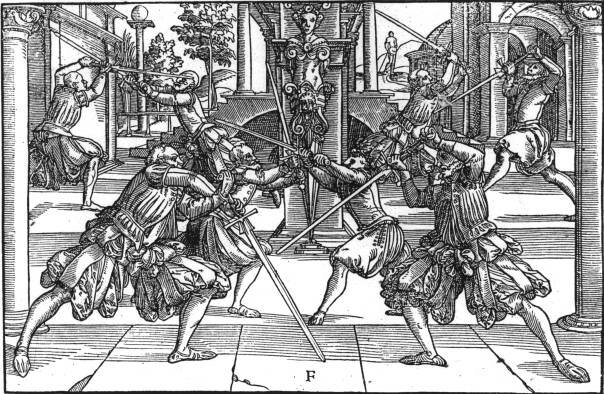
Page 9

Hangetort Wie du das Hangetort in das werck richten solt, lehrt dich das Bild zur Rechten in obgedachter Figur, allein das darinen die Arm nit gnügsam gestreckt hie angezeigt wirt, Derwegen schicke dich In gemelde Hut also, stehe mit dem rechten Fuß vor, halt deine Wehr mit außgestreckten Armen vor dir, das die Klingen etwas undersich gegen der Erden hange, diß Leger ist durchauß fast dem Ochsen gleichförmig, allein das du im Ochsen die Arm starck in die höhe empor heltest, hie aber gerad vor deinem Gesicht außgestreckt sein sollen, unnd das Schwerdt gegen der Erden hangen lassest, darumb es denn auch das hengetort geheissen.
Since you'll need to be in the correct Hanging Point during the work, look at the figure to the right of the above illustration. Even if the arms needn't be as stretched as here will be shown, still put yourself into the named Guard. Stand with the right foot forward, hold your weapon with outstretched arms before you, so that the blade hangs somewhat toward the earth, this stance is very close to the Ox in similar form, only different in that in the Ox your arms are strongly held in high mode, but here shall be directly outstretched before your face, letting the Sword hang toward the Earth, therefore it is named Hanging Point.
Note: See also Talhoffer tafel 23 for more on the Hanging Point.
Schlüssel Der Schlüssel ist in der Figur welche mit dem Buchstaben D. verzeichnet, also fürgebildet, stehestu mit deinem Lincken fuß vor, und haltest dein Schwerdt mit dem Hefft und gecreutzigten henden vor deiner Brust, das die kurtze schneide auff dem Lincken Arm lige, und das ort gegen des Mans gesicht stehe, so wirt diß Leger oder Hut recht gemacht.
The Key is shown by the left figure in illustration D, stand with your Left foot forward, and hold your Sword with the haft and crossed arms in front of your chest, so that the short edge lies on your Left Arm, and the point is aimed at your opponent's face. Thus is this stance or guard rightly made.
See also Sutor page 9 for more on the Key.
Eynhorn Komm im zufechten mit dem Lincken Fuß vor, flügel von beiden seiten auff, als wollestu dich in vorgenanten Schlüssel Legern, fahre mit geschrenckten henden ubersich zu deiner Rechten, das die spitz in der höhe obersich her auß sehe, so heist es im Einhorn, unnd stehest wie du in der Figur hie gegen mit dem E. gezeichnet am bildt zur Rechten sehen kanst.
Come into pre-fencing with your Left foot forward, wings out from both sides, as if you would stand in the forenamed Key guard, drive with crossed hands overhead on your Right, so that the point is aimed high above and outward, thus it is named Unicorn, and stand as shown by the figure on the Right of illustration E.
And thus are named the count of the Stances or Guards, and now all in the work phase will be fully and shortly examined. After this point in all fencing, you will Strike, Strive, Displace, or float to work for what you wish, and not remain in a stance, but always drive from one to the other, as one or the other must soon become afflicted, thus you especially must move on to keep the working initiative, and will lead out from one to another of the above cited stances, which I will clarify with a few words about the strikes through the lines or pathways.
Und diß sey von den Namen der anzal der Leger oder Huten, un wie ein jedes ins werck gesetzt oder volbracht wird, kürtzlich vermeldet. Nach dem aber in allem Fechten, du Hauwest, Arbeitest, Versetzest, oder treibest für arbeit was du wollest, nicht in einem Leger verharren, sonder alweg auß einem in das ander verfahren, unnd eines in das ander verwandlen must, wil dir in sonderheit gebüren ein gut fleissigs auffmercken zu haben, wie oberzeiten Leger eins auß dem andern ervolgen, welches ich dañ mit den Hauwen durch die Linien oder strassen etlicher massen mit wenig worten will erkleren.